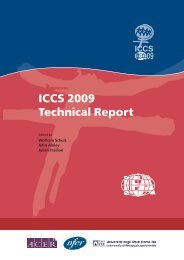Teacher Education and Development Study in Mathematics - IEA
Teacher Education and Development Study in Mathematics - IEA
Teacher Education and Development Study in Mathematics - IEA
Create successful ePaper yourself
Turn your PDF publications into a flip-book with our unique Google optimized e-Paper software.
152<br />
TEACHER PAY AND STUDENT MATHEMATICS ACHIEVEMENT<br />
Switzerl<strong>and</strong> 23<br />
Composition of the teacher labor force<br />
The labor market for teachers <strong>in</strong> Switzerl<strong>and</strong> is stratified accord<strong>in</strong>g to level of education,<br />
type of program, type of provider (public or private), region of the country (cantons<br />
<strong>and</strong> communes), <strong>and</strong> subject matter (OECD, 2004a). Any imbalance between supply of<br />
teachers <strong>and</strong> dem<strong>and</strong> relates to imbalances <strong>in</strong> different sub-markets for teachers.<br />
Results from the OECD International Survey of Upper Secondary Schools (ISUSS)<br />
<strong>in</strong>dicated that, <strong>in</strong> 2001/2002, the percentage of full-time equivalent teach<strong>in</strong>g positions<br />
to be filled stood at 13.9% of the total full-time requirement. This percentage was above<br />
the OECD country mean of 12.3% (OECD, 2004a). Qualitative shortages were also<br />
evident, although more at the lower-secondary <strong>and</strong> upper-secondary level than at the<br />
primary level.<br />
Although difficulties <strong>in</strong> recruit<strong>in</strong>g teachers exist at different levels of the labor market,<br />
the situation is worst at the lower-secondary level. Each advertised position typically<br />
attracts between only one <strong>and</strong> five applicants, limit<strong>in</strong>g the choice-set considerably. The<br />
situation is particularly acute <strong>in</strong> mathematics <strong>and</strong> physics (OECD, 2004a). Pr<strong>in</strong>cipals<br />
<strong>in</strong> upper-secondary schools say that the subject areas for which they have the greatest<br />
difficulty hir<strong>in</strong>g teachers are mathematics, computer sciences, <strong>and</strong> the sciences. The<br />
situation appears to be less problematic <strong>in</strong> the social sciences (OECD, 2004a).<br />
The teach<strong>in</strong>g force <strong>in</strong> Switzerl<strong>and</strong> is ma<strong>in</strong>ly female (just over 72% of all teachers <strong>in</strong><br />
public schools were female <strong>in</strong> 1999 at the primary level). The proportions change as one<br />
moves to higher levels: only 45% of teachers are female at the lower-secondary level;<br />
around 32% are female at the upper-secondary level (OECD, 2004a).<br />
A study by Henneberger <strong>and</strong> Souza-Poza <strong>in</strong> 2002 put the turnover rate for the teach<strong>in</strong>g<br />
sector as a whole at approximately eight percent. This figure was below the average of<br />
just over 10% for all sectors <strong>in</strong> the economy. There was some variation across cantons,<br />
where the range was 5% to 11%. Because the teach<strong>in</strong>g force is not particularly old,<br />
retirement does not expla<strong>in</strong> turnover <strong>in</strong> any significant way (OECD, 2004a).<br />
<strong>Teacher</strong> recruitment, hir<strong>in</strong>g, <strong>and</strong> education<br />
The task of recruit<strong>in</strong>g, select<strong>in</strong>g, <strong>and</strong> appo<strong>in</strong>t<strong>in</strong>g teach<strong>in</strong>g staff <strong>in</strong> Switzerl<strong>and</strong> is<br />
the responsibility of the cantonal <strong>and</strong> communal authorities together with the<br />
commune’s school committees <strong>and</strong> the schools’ management/pr<strong>in</strong>cipals. The degree<br />
of <strong>in</strong>volvement of each of these stakeholders varies by canton. Generally, the school<br />
pr<strong>in</strong>cipal/management plays the major role <strong>in</strong> recruitment <strong>and</strong> selection, even when<br />
the formal responsibility lies with the school committees. This trend is especially true<br />
of upper-secondary schools <strong>and</strong> schools <strong>in</strong> the French-speak<strong>in</strong>g part of the country. No<br />
st<strong>and</strong>ard procedure is followed dur<strong>in</strong>g recruitment <strong>and</strong> hir<strong>in</strong>g. In many cases, teachers<br />
have the right to suggest who should be recruited. Sometimes they participate <strong>in</strong> the<br />
selection process <strong>in</strong> their capacity as members of the school committee. The selection<br />
procedure is, however, thorough. It typically <strong>in</strong>volves consideration of applicants’ files<br />
<strong>and</strong> “portfolios,” a guided visit of the school, <strong>in</strong>terviews, <strong>and</strong> sometimes a probationary<br />
23 Unless stated otherwise, <strong>in</strong>formation <strong>in</strong> this section is drawn from http://www.about.ch/education/<strong>in</strong>dex.html.

















